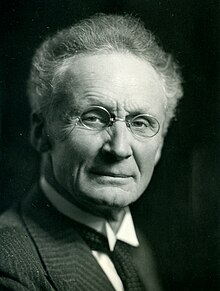Vilhelm Bjerknes
| Vilhelm Bjerknes | |
|---|---|
 |
|
| Born |
14 March 1862 Christiania, Norway |
| Died | 9 April 1951 (aged 89) Oslo, Norway |
| Citizenship | Norwegian |
| Fields | physicist and meteorologist |
| Doctoral advisor | Heinrich Hertz |
| Known for | The Development of Modern Weather Forecasting, Bergen School of Meteorology |
| Influences | Heinrich Hertz Henri Poincaré Carl Anton Bjerknes |
| Notable awards |
Fellow of the Royal Society Symons Gold Medal, 1932 |
| Signature | |
Vilhelm Friman Koren Bjerknes ForMemRS (/ˈvɪlˌhɛlm ˈbjɜːrknᵻs/; 14 March 1862 – 9 April 1951) was a Norwegian physicist and meteorologist who did much to found the modern practice of weather forecasting.
Born in Christiania, Bjerknes enjoyed an early exposure to fluid dynamics, as assistant to his father, Carl Anton Bjerknes, who had discovered by mathematical analysis the apparent actions at a distance between pulsating and oscillating bodies in a fluid, and their analogy with the electric and magnetic actions at a distance. Apparently no attempt had been made to demonstrate experimentally the theories arrived at by the older professor until Vilhelm Bjerknes, then about 17 or 18 years of age, turned his mathematical knowledge and mechanical abilities to the devising of a series of instruments by which all the well-known phenomena of electricity and magnetism were illustrated and reproduced by spheres and discs and membranes set into rhythmic vibration in a bath containing a viscous fluid such as syrup. These demonstrations formed the most important exhibit in the department of physics at the Exposition Internationale d'Électricité held in Paris in 1881, and aroused greatest interest in the scientific world.
Vilhelm Bjerknes became assistant to Heinrich Hertz in Bonn 1890–1891 and made substantial contributions to Hertz' work on electromagnetic resonance. He succeeded in giving the explanation of the phenomenon called "multiple resonance," discovered by Sarasin and De la Rive. Continuing his experiments at the University of Christiania (1891–1892), he proved experimentally the influence which the conductivity and the magnetic properties of the metallic conductors exert upon the electric oscillations, and measured the depth to which the electric oscillations penetrate in metals of different conductivity and magnetic permeability (the "skin effect"). Finally, in 1895 he furnished a complete theory of the phenomenon of electric resonance, involving a method of utilizing resonance experiments for the determination of the wavelengths, and especially of the damping (the logarithmic decrement) of the oscillations in the transmitter and the receiver of the electric oscillations. These methods contributed much to the development of wireless telegraphy. His papers on electric oscillations were published in Annalen der Physik (1891–1895).
...
Wikipedia
